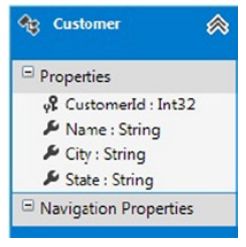《Entity Framework 6 Recipes》中文翻译系列 (21) -----第四章 ASP.NET MVC中使用实体框架之在页面中创建查询和使用ASP.NET URL路由过虑
翻译的初衷以及为什么选择《Entity Framework 6 Recipes》来学习,请看本系列开篇
4.2. 构建一个搜索查询
搜索数据是几乎所有应用的一个基本功能。它一般是动态的,因为用户可能使用提供的任何一个条件,或者一个也不使用。所以,我们在下面讨论实现这个基本功能的一些细节。
问题
你想在ASP.NET MVC4中使用实体框架构建一搜索页面。
解决方案
假设你有如图4-14所示的模型,在这个解决方案中,我们打算使用三个基本的部分来构建搜索页:
1、一张用于构造查询参数的表;
2、一个用于在Razor视图中呈现结果的WebGrid;
3、一个包含视图逻辑的Cotroller;
在数据库中,你有一张Customer表,它存储所有客户的Name,City和State信息。Customer表的数据模型(架构)如图4-14所示。
图4-14 一个包含Customer 实体的模型
在Customer视图模型被创建之后,我们需要使用Razor来编写视图。在这个视图中,我们使用WebGrid控件来显示Customer记录。如代码清单4-5所示。
代码清单4-5. 在MVC Razor视图中使用WebGrid
1 @model EntityFrameworkRecipe2.ViewModels.CustomerVM 2 3 @{ 4 Layout = null; 5 } 6 7 @{ 8 ViewBag.Title = "Customer"; 9 WebGrid grid = new WebGrid(canPage:false,canSort:false); 10 grid.Bind(Model.Customers, 11 autoSortAndPage: false 12 ); 13 } 14 15 @using (Html.BeginForm()) 16 { 17 <table> 18 <tr> 19 <td> 20 Name 21 </td> 22 <td> 23 @Html.TextBoxFor(model => model.Name) 24 </td> 25 </tr> 26 <tr> 27 <td> 28 City 29 </td> 30 <td> 31 @Html.TextBoxFor(model => model.City) 32 </td> 33 </tr> 34 <tr> 35 <td> 36 State 37 </td> 38 <td> 39 @Html.TextBoxFor(model => model.State) 40 </td> 41 </tr> 42 <tr> 43 <td colspan="2"> 44 <input type="submit" id="search" title="Search" value="Search" /> 45 </td> 46 </tr> 47 </table> 48 <div id="searchResults"> 49 <!-- placeHolder for search results --> 50 @grid.GetHtml( 51 fillEmptyRows: true, 52 alternatingRowStyle: "alternate-row", 53 headerStyle: "grid-header", 54 footerStyle: "grid-footer", 55 columns: new [] { 56 grid.Column("Name"), 57 grid.Column("City"), 58 grid.Column("State") 59 }) 60 </div> 61 }
一旦视图编写好,我就开始在Controller中编写支持Get和Post方式的查询功能。我们打算将从数据库中获取的Customer数据放到 view modle中,实现如代码清单4-6所示.
代码清单4-6. 获取数据代搜索页测试
1 public class CustomerController : Controller 2 { 3 public ActionResult Search() 4 { 5 using (var db = new CustomerEntities()) 6 { 7 var customer = db.Customers.ToList(); 8 var data = new CustomerVM() 9 { 10 Customers = customer 11 }; 12 return View(data); 13 } 14 } 15 [HttpPost] 16 public ActionResult Search(CustomerVM customerVmValue) 17 { 18 using (var db = new CustomerEntities()) 19 { 20 var customerSearchResults = from customerRec in db.Customers 21 where ((customerVmValue.Name == null) || (customerRec.Name == customerVmValue.Name.Trim())) 22 && ((customerVmValue.City == null) || (customerRec.City == customerVmValue.City.Trim())) 23 && ((customerVmValue.State == null) || (customerRec.State == customerVmValue.State.Trim())) 24 select new 25 { 26 Name = customerRec.Name 27 , 28 City = customerRec.City 29 , 30 State = customerRec.State 31 }; 32 List<Customer> lstCustomer = new List<Customer>(); 33 foreach (var record in customerSearchResults) 34 { 35 Customer customerValue = new Customer(); 36 customerValue.Name = record.Name; 37 customerValue.City = record.City; 38 customerValue.State = record.State; 39 lstCustomer.Add(customerValue); 40 } 41 customerVmValue.Customers = lstCustomer; 42 return View(customerVmValue); 43 } 44 } 45 }
图4-15 浏览器中呈现的视图
原理
在页面的第一小节中(请看代码清单4-5),我们使用table来格式化查询字段,这里没有花俏的技术,我们只是提供了获取三个查询字段:Name,City和State的结构。他们的值(或者没有),将用于查询按钮被点击了之后Controller的查询(Search)动作方法.因此,这些参数会成为查询的过虑条件。
接下来,我们使用HtmlHelper在WebGrid控件中显示结果集。数据源使用view model。这里需要注意,我们创建了两个模型,一个用于从数据库中获取数据,一个用于视图页收集查询参数,和呈现结果集。
我们使用Linq to entities来查询数据模型中的Customer实体,where从句和参数确定了我们的查询过滤。在视图中,我们将查询参数Name,City和State映射到 HtmlHelper中的文本框。将Name属性映射到文件框Name,依次类推。
我们使用控件WebGrid来显示结果集,它被绑定到CustomerVM.Customers列表,它是专门用来获取查询结果集的。
代码清单4-6中所展示的controller代码,从数据库中获取数据,并在第一次加载视图和点击查询按钮后填充视图。我们使用了本地数据库.mdf文件并在Customer表中填充了记录。
4.3. 使用ASP.NET的URL路由过虑
问题
你想使用MapRoute来简化你的URLs,同时你想凭借这位路由在Razor视图引擎中过滤结果集。
解决方案
假设你有如图4-16的模型,我们已经对产品以及它们的目录建模,用实体类型Product来表示产品。在一个典型的电商网站中,我们需要按目录对产品进行分类。我们要避免在URLs中暴露类似 "/Product/Index?Category=Tents"这样的查询字符串。虽然这样会使编程简单一些,但无益于搜索引擎优化。我们需要看起像 “/Producs/Tents"这样的URLs.
图4-6 一个包含products和它们的categories
我们能通过路由得到对搜索引擎友好的URL,路由一般在Global.asax的Application_Start()事件处理函数中创建。代码清单4-7演示了为Product控制器添加一条路由。
代码清单4-7. 在Global.asax中创建一条路由
1 protected void Application_Start() 2 { 3 AreaRegistration.RegisterAllAreas(); 4 5 WebApiConfig.Register(GlobalConfiguration.Configuration); 6 FilterConfig.RegisterGlobalFilters(GlobalFilters.Filters); 7 RouteTable.Routes.MapRoute("Product", "{controller}/{name}", 8 new { controller = "Product", action = "Index" } 9 ); 10 RouteConfig.RegisterRoutes(RouteTable.Routes); 11 BundleConfig.RegisterBundles(BundleTable.Bundles); 12 AuthConfig.RegisterAuth(); 13 }
在代码清单4-8所示的Index视图中,我们使用category name绑定到Product controller中的Inde动作方法的name参数,如代码清单4-7所示。我们使用代码清单4-9中的代码获取category name参数的值,并通过视图处理结果集。图4-17和图4-18分别展示了呈现Tents目录下产品的视图页面,和Cooking Equipment目录下产品的视图页面。
代码清单4-8. Index视图代码,它显示通过目录过滤后的产品
1 @model IEnumerable<EntityFrameworkRecipe3.ViewModels.ProductVM> 2 3 @{ 4 Layout = null; 5 } 6 7 <!DOCTYPE html> 8 9 <html> 10 <head> 11 <meta name="viewport" content="width=device-width" /> 12 <title>Index</title> 13 </head> 14 <body> 15 <table> 16 <tr> 17 <th> 18 @Html.DisplayNameFor(model => model.Name) 19 </th> 20 <th> 21 @Html.DisplayNameFor(model => model.CategoryName) 22 </th> 23 <th></th> 24 </tr> 25 26 @foreach (var item in Model) { 27 <tr> 28 <td> 29 @Html.DisplayFor(modelItem => item.Name) 30 </td> 31 <td> 32 @Html.DisplayFor(modelItem => item.CategoryName) 33 </td> 34 </tr> 35 } 36 37 </table> 38 </body> 39 </html>
代码清单4-9. Controller代码,使用通过Category Name过滤后的Product数据填充模型
1 public class ProductController : Controller 2 { 3 // 4 // GET: /Product/ 5 6 public ActionResult Index(string name) 7 { 8 using (var db = new ProductEntities()) 9 { 10 var query = from productRec in db.Products 11 join categoryRec in db.Categories 12 on productRec.CategoryId 13 equals categoryRec.CategoryId 14 where categoryRec.Name == name 15 select new 16 { 17 Name = productRec.Name 18 , 19 CategoryName = categoryRec.Name 20 }; 21 List<ProductVM> lstProduct = new List<ProductVM>(); 22 foreach(var record in query) 23 { 24 ProductVM productValue = new ProductVM(); 25 productValue.Name = record.Name; 26 productValue.CategoryName = record.CategoryName; 27 lstProduct.Add(productValue); 28 } 29 return View(lstProduct); 30 } 31 } 32 33 }
图4-17 使用路径“/Product/Tents",得到Tents目录类别的产品集
图4-18 使用路径“/Product/cooking Equipment"得到cooking Equipment目录类别的产品集
原理
在Global.asax中 Applicate_Start()事件处理函数中,我们为之前的"/Product/Index?name=category"映射了路由 "/Product/{name}".在Product controller中,我们使用MapRoute中的路由key,name,过滤结果集,通过给定的目录过滤产品。
至此,第四章结束,感谢你的阅读。下一篇,我们将进入第五章的学习。
实体框架交流QQ群: 458326058,欢迎有兴趣的朋友加入一起交流
谢谢大家的持续关注,我的博客地址:http://www.cnblogs.com/VolcanoCloud/




